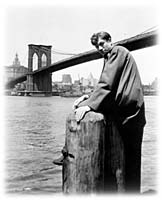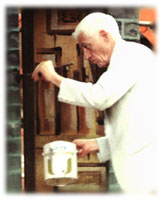Biography of Oliver Smith
Once, in answering a questionnaire concerning the working methods of theatre people, I was asked what Oliver Smith did while preparing for a show. I replied, “two others,” and added “and a delightful six-day trip.” Why do people put up with all this? Because he’s just that good. They want him. Present or absent, his scenery is delivered ontime, and it works. His best scenery makes theatre history.
– Agnes de Mille
Winner of eight Tony Awards, five Donaldson Awards, New York City’s Handel Medallion, and numerous other honors, Oliver Smith designed for the theatre, dance, opera, and film. His scenic designs for musical comedy spanned a golden age on Broadway from the 40s to the 70s, including My Fair Lady, Hello, Dolly!, West Side Story, On the Town, Brigadoon, Camelot, and over sixty others; his designs for the dance included Rodeo, Fall River Legend, Les Noces, Fancy Free (and many others for American Ballet Theatre, which he co-produced for forty years with Lucia Chase); his films included Bandwagon, Guys and Dolls, and Oklahoma!; and his opera designs graced the stages of the Metropolitan and New York City Operas.
In the course of this prodigious career, Oliver Smith collaborated closely with major figures in American arts and letters, ranging from Leonard Bernstein and Agnes de Mille to Jerome Robbins, Tennessee Williams, and Truman Capote. His distinctly American vision illuminated the music, dance, and language of many of the most remarkable creative works produced on the twentieth-century stage, and his work as a producer brought original productions by Jean-Paul Sartre (No Exit) and Jane Bowles (In the Summer House), among others, to the Broadway stage. Smith’s talent for choreographic movement of scenery and his chameleon-like ability to work in a wide variety of artistic styles in the service of widely differing productions found expression in his artwork: thousands of renderings and backdrop elevations executed in watercolor, dye, ink, and gouache.
 Oliver Smith (1918-1994) was born in Waupun, Wisconsin, to a high school principal and his arts-loving wife, who encouraged Smith’s early interest in architecture, literature, and the performing arts. After his parents divorced and his mother remarried, Smith moved east, where his stepfather owned a store in Wellsboro, Pennsylvania. A quintessentially American artist, Smith began painting as an undergraduate architecture student at State College in Pennsylvania, and planned to study playwrighting at Yale.
Oliver Smith (1918-1994) was born in Waupun, Wisconsin, to a high school principal and his arts-loving wife, who encouraged Smith’s early interest in architecture, literature, and the performing arts. After his parents divorced and his mother remarried, Smith moved east, where his stepfather owned a store in Wellsboro, Pennsylvania. A quintessentially American artist, Smith began painting as an undergraduate architecture student at State College in Pennsylvania, and planned to study playwrighting at Yale.
However, he decided to stop over in New York City for a year on his way to graduate school in Connecticut, arriving in the fall of 1939. His cousin, composer and writer Paul Bowles, suggested that Smith could find cheap lodgings in Brooklyn Heights, thus introducing him to the borough he adopted as home for the rest of his life.
In the Heights, Smith moved into a brownstone rooming house at 7 Middagh Street owned by George Davis (an editor at Harper’s Bazaar). This house, now demolished, is famed in the annals of literature, as it was tenanted by Paul and Jane Bowles, W. H. Auden, Benjamin Britten, Carson McCullers, Richard Wright, John LaTouche, and Gypsy Rose Lee. Auden presided over the communal dinners and collected the rent; Wright landscaped the rooming house’s abandoned rear garden and charged admission to the other residents to cover his expenses. It was at 7 Middagh Street that Smith began forging the show-business contacts that were to stand him in good stead for a lifetime.
During his year in New York City, Smith supported himself by working at department stores, as well as ushering at the Roxy, and clerking at the Brooklyn Public Library. He kept on painting, and had an exhibit at Manhattan’s Bonestelle Gallery, featuring his atmospheric depictions of the New York waterfront and Manhattan as seen from Brooklyn Heights. When little sold, Smith sought advice from Bowles. How could he make a living as an artist? Should he move on to Yale? His cousin advised the despondent Smith, “You paint, and you like the theatre. So paint for the theatre.” The idea appealed, and Smith launched an intense effort to create a theatrical portfolio and break into the scenic design business. It was a field uniquely suited to his talents, for his sensitivity to the sculpting of space made for scenic designs that were not only esthetically beautiful, but tailored to the practical needs of individual productions.
In 1941, Smith’s work for Massine’s ballet Saratoga was hailed by a New York critic as a breakthrough in American scenic design. Agnes De Mille’s Rodeo followed in 1942, and On The Town and Fancy Free (with Jerome Robbins and Leonard Bernstein) in 1944. Smith’s scenery won raves for each, and he was in demand for both Broadway and ballet assignments. He inked his first movie deal, for Oklahoma!, in 1953 – the same year he purchased a federal yellow brick mansion on Willow Street in Brooklyn Heights. This house (which Truman Capote, a tenant of Smith’s, described enviously in his short story, A House on the Heights) remained Smith’s residence for the rest of his life. Throughout his career, Oliver Smith’s work blended a distinctly American painting style with the grace of his moving scenery, creating designs that earned accolades around the world.
